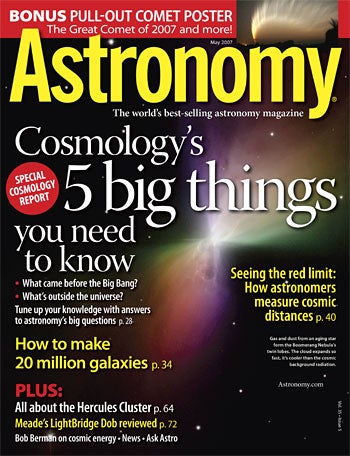
April 4, 2007
WAUKESHA, WI – Have you ever doubted the Big Bang? Ever wondered what’s outside the universe?
Astronomers define such musings as cosmological. Astronomy magazine’s May 2007 issue offers readers a special report, “Cosmology: 5 things you need to know.” It’s sure to give beginners and advanced astronomers pause for thought, as Liz Kruesi takes on the top five sources of cosmic confusion and the biggest stumbling blocks in understanding the universe.
And staying within the cosmological realm, Astronomy Contributing Editor Steve Nadis tackles the computer-simulated history of the universe in “How to make 20 million galaxies.” Nadis argues that galaxies have continuously formed since the universe’s earliest moments, and only through numerical simulations can we fill in the gap between the early universe and the “cosmic web” we know today.
Astronomy‘s May issue hits the newsstands Tuesday, April 3, and features “The Great Comet of 2007,” which burst onto the scene earlier this year. Plus, readers get a bonus pull-out poster, “On the trail of Comet McNaught.” This poster includes an illustrated history of great comets and a gallery of comet close-ups.
Astronomy‘s mission:
Astronomy promotes the science and hobby of astronomy through high-quality publications that engage, inform, entertain, and inspire.
More resources from Astronomy.com:
- Astronomy news
This week’s sky events
Astronomy basics
Glossary of astronomical terms
Return to Astronomy “For the media” page
Cosmologists have made great strides in past years, including pinning down the universe’s age and explaining for its rapid expansion. Still, scientists can make no claim that our current model of the universe is complete. Is today “cosmology’s golden age?” Liz Kruesi’s “Cosmology: 5 things you need to know” brings to light some of cosmology’s most fundamental ideas.
Investigating cosmic evolution
Steve Nadis’ “How to make 20 million galaxies” explores the Millennium Run – a simulated view of cosmic evolution. This story of the universe lies in an array of magnetic tapes and disk drives in Germany and England. This history, essentially, covers cosmic evolution from about 10 million years after the Big Bang until the present, telling how particles came together to form the structure of the universe today.
Seeing red
Our galaxy is but one of tens of millions astronomers have observed, and some galaxies lie farther than a billion light-years away. But how do astronomers know this? “Seeing the red limit” explains the phenomenon of redshift – the displacement of a galaxy’s light toward longer wavelengths. Ultimately, understanding redshift is the key to unlocking many mysteries of the cosmos, including how astronomers measure distances in space.
The Great Comet of 2007
Robert McNaught discovered his comet in August 2006 from his observatory in New South Wales, Australia. It remained quiet for several months, until December, when it finally began to brighten. In January 2007, Comet McNaught became the brightest comet since Ikeya-Seki in 1965. Astronomy Senior Editor Richard Talcott‘s “The Great Comet of 2007” includes the play-by-play of the Great Comet, as well as stunning photos from around the globe of its impressive show.
Also in this issue
- “A tail of two comets” – Comet McNaught’s multi-spiked tail bore a striking resemblance to that of 1744’s great comet.
- “All about the Hercules cluster” – Globular clusters like M13 helped astronomers refine our galaxy’s structure.
- “How to avoid the astronomy blues” – Many telescope buyers become discouraged after a short time. Here’s how to evade that trap.
- “Deep-sky-object hunter” – Meade Instrument Corporation’s LightBridge Dobsonian will help observers see faint details in distant targets.
- The May issue also includes Ask Astro, Astro News, Bob Berman’s strange universe, Glenn Chaple’s observing basics, Phil Harrington’s binocular universe, Stephen James O’Meara’s secret sky, The sky this month, New products, and Reader gallery.









